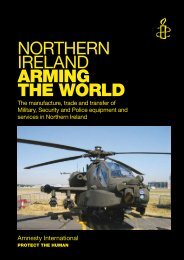CROWD CONTROL TECHNOLOGIES - Omega Research Foundation
CROWD CONTROL TECHNOLOGIES - Omega Research Foundation
CROWD CONTROL TECHNOLOGIES - Omega Research Foundation
You also want an ePaper? Increase the reach of your titles
YUMPU automatically turns print PDFs into web optimized ePapers that Google loves.
the bio-regulator endthelia (which is a very powerful constrictor of blood vessels and can produce<br />
aneurysms) have been noted. The potential for malign applications emerging for semi-lethal crowd<br />
control from this research should not be dismissed. Arguably there should be a set of new norms<br />
regarding the use of such momentous knowledge of life processes for human manipulation and<br />
control. 369<br />
The issue is too complex to be adequately covered by this study but the potential significance of<br />
developments in biotechnology leading to a third generation of instruments to manipulate human<br />
behaviour deserves a specialist study in its own right. If such a study could be completed in time for the<br />
BTWC 2001 review conference, it could help produce a greater scientific knowledge of these issues<br />
and gain further support for strengthening the convention.<br />
6.5 International Humanitarian Agencies have been very circumspect about the alleged non-lethality<br />
of these technologies. Dominique Loye of the ICRC has emphasized that:- )there is an urgent need to<br />
study carefully the potential physical and psychological effects of new technologies such as infrasound,<br />
electromagnetic waves or even sticky foam on humans. We would hope, for example, that it is<br />
not the aim of the weapons research community to introduce into police and military arsenals<br />
technologies which may be non-lethal but which will have permanent or non-treatable effects. Yet even<br />
the temporary effects may need specialised medical treatment which is not available in many countries<br />
and which is very often not available on the battlefield. We also hope that it is not the intention of the<br />
promoters of non-lethal weapons to increase the lethality of warfare. Yet these weapons could do just<br />
that if used in conjunction with lethal force, which is how we understand they are to be deployed.( 370<br />
His colleague, surgeon Robin Coupland has pointed out that under article 35 of the Geneva<br />
protocols, 150 countries have already agreed to ban )weapons, projectiles and material and methods<br />
of warfare of a nature to cause superfluous injury or unnecessary suffering.( Since the protocol was<br />
signed in 1977 little effort has been made to work out what this means in practice. Coupland asks if is<br />
right that weapons manufacturers and the military should decide the answer? E.g. if sticking foam is<br />
used in a conflict situation, people could suffocate or be left for dead. 371 The extent to which these new<br />
technologies can undermine international treaties and human rights law is a crucial issue. The<br />
manufacturers and proponents of these technologies are acutely aware of this dimension but the<br />
commercial pressure on them to push the envelope are intense. ICRC with its SIrUS project has<br />
adopted a new approach based on the actual weapons design which invites abusability. For example,<br />
all weapons which are currently banned by international law, such as poison gas, exploding bullets,<br />
blinding laser weapons and landmines, were designed to inflict a specific injury and to do so<br />
consistently. According to ICRC it is time to put a ban on any non-lethal weapon that causes<br />
superficial injury or unnecessary suffering by specifically singling out anatomical, biochemical or<br />
physiological targets. 372 Australia is the first country to commit itself to taking SirUS criteria into account<br />
when reviewing its weapons policies. 373<br />
Other critics say that the notion of soft-kill is a fallacy. The Nobel prize winning scientific<br />
organization Pugwash, has come to the conclusion that the term non-lethal should be abandoned, not<br />
only because it covers a wide variety of different weapons but also because it can be dangerously<br />
misleading. )In combat situations, sub-lethal weapons are likely to be used in co-ordination with other<br />
weapons and could increase overall lethality. Weapons purportedly developed for conventional military<br />
or peacekeeping use are also likely to be used in civil wars or for oppression by brutal governments.<br />
Weapons developed for police use may encourage the militarisation of police forces or be used for<br />
torture. If a generic term is needed, less-lethal or pre-lethal might be preferable(. 374<br />
The reality can indeed be far from non-lethal. A current and future domain of this weaponry is<br />
during internal security operations, where it provides authoritarian regimes with new tools for crushing<br />
dissent. Already variants of less-lethal paralysing and incapacitating electroshock weapons have<br />
found a role in torture. 375 The new weapons potentially offer the torturing states a spine chilling arsenal<br />
of repressive instruments. Whilst the genie of advanced crowd control weapons may not go back into<br />
lv




